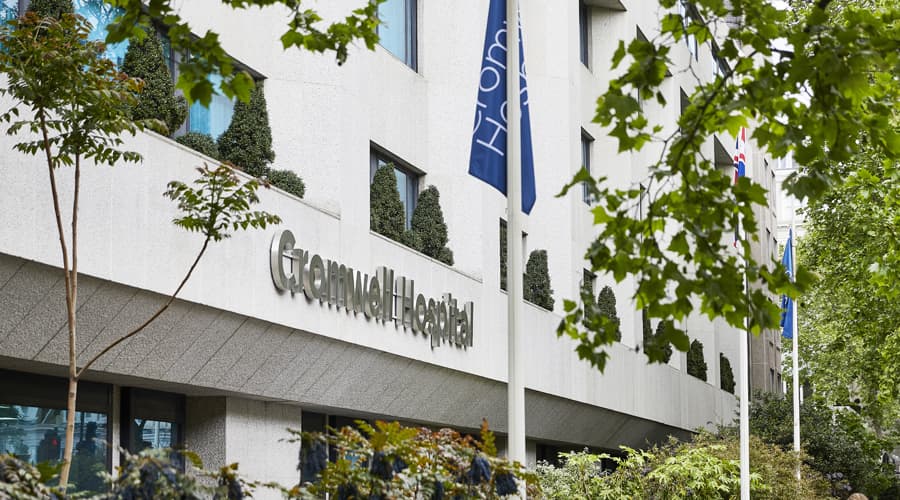Gastric band surgery
Gastric band surgery is a type of weight loss surgery that involves attaching an inflatable band around the top of your stomach.
Reviewed by Mr Ahmed Ahmed, Consultant GI and Bariatric Surgeon
At a glance
Who's it for?
Patients with a BMI above 30.
What's involved?
An inflatable silicone ring is attached around the top of your stomach, which reduces its size and makes you feel fuller quicker.
What's recovery like?
The procedure takes 30 minutes and can be performed as a day case (same-day discharge home).
What is gastric band surgery?
Gastric band surgery is a type of weight loss surgery that works by reducing the size of your stomach.
An inflatable silicone ring is attached around the top of your stomach. It works by slowing down how quickly food moves into your stomach, making you feel full earlier during a meal.
The ring creates a small pouch with a narrow opening, or channel, to the rest of the stomach. The size of the pouch and the channel depends on how much the ring is inflated. The band is connected to a small port, just under the skin, which allows it to be adjusted in size.
You are likely to be recommended gastric band surgery if:
- your BMI is above 30
- you have previously tried and failed to lose weight
- you have, or are at risk of, type 2 diabetes
You must also be willing to commit to long-term dietary and lifestyle changes, which will be monitored at follow-up appointments.
Gastric band surgery is done under general anaesthetic, so you’ll be asleep during the operation.
The procedure will be carried out laparoscopically. A laparoscopic procedure (also known as keyhole surgery) allows the surgeon to access your abdomen using smaller incisions, rather than one larger one.
A laparoscope is a small, thin tube that has a light source and camera on one end. When inserted through the abdominal incisions, the video images from this instrument guide the surgeon in carrying out the procedure.
During the operation, an inflatable band is placed around the top part of your stomach, which creates a small pouch above the band. This band is connected by a fine tube to an injection port, which sits under the skin of the abdomen. Your surgeon will stitch this in place. The cuts in your abdomen will be closed using clips or dissolvable stitches.
After surgery, you will be given pain relief to help alleviate any discomfort. Around four hours following the procedure, you will be encouraged to get up and start moving around. You will be on a liquid-only diet after the procedure, with a gradual return to solid food after one week.
You’ll normally be able to go home the same day as the operation. You can resume walking as soon as possible and return to work and normal activities within a week of surgery. You can travel one week after surgery.
If the cuts in your abdomen have been closed with clips, these will need to be removed about one week after surgery.
About four to six weeks after surgery, your surgeon will make the first adjustment to your gastric band. This will be done at a clinic appointment and is carried out by injecting saline solution into the band via the port. Further band fills will be necessary on a monthly basis, usually four to six times per year.
Following the procedure, you may experience mild side effects like heartburn, nausea, vomiting and stomach pain.
Complications are rare, but may include:
- your gastric band slipping out of place or eroding into the stomach
- leaking from the stomach
- wound infection
- port site problems (displacement/infection)
There are several different types of bariatric treatment, both surgical and non-surgical. If you would prefer a non-surgical approach, we offer treatments including weight loss injections, gastric balloons and endoscopic sleeve gastroplasty (ESG).
Why choose us for gastric band surgery?
World-class bariatric surgeons
Our consultant bariatric surgeons are experts in their field, having trained at top UK teaching hospitals.
Tailored dietary advice
Our dietitians work with patients to create tailored meal plans that support their health and weight loss goals.
Behavioural support
Weight loss programmes are delivered with the support of specialist psychiatrists and psychologists.
Specialist anaesthetist
Weight loss surgeries are supported by our specially trained bariatric anaesthetist.
Paying for your treatment
We welcome both self-paying and insured patients.
Self-pay patients
We offer several ways for patients to self-pay, including pay-as-you-go and self-pay packages.
Insured patients
At Cromwell Hospital, we accept private health insurance from most major providers, including AXA, Aviva, Bupa, and Vitality.
Our locations

Book an appointment today
Call us now for appointment bookings, general queries, and personalised quotes.
Alternatively, you can contact us using our online form.
